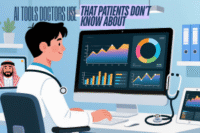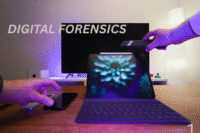Wearable Technology – Revolutionizing Health and Fitness
Published: 22 Apr 2025
Wearable technology is transforming health and fitness by offering real-time insights, smart features, and seamless connectivity for modern lifestyles. From smartwatches to AR glasses, these innovative gadgets act as personal health coaches and productivity assistants-perfect for tech-savvy users seeking smarter living. Whether you’re tracking your heart rate, managing daily tasks, or staying active, wearable devices are reshaping how we interact with technology.
What is Wearable Technology?
Wearable technology refers to electronic devices worn on the body that combine health monitoring, communication tools, and data tracking features.

These gadgets integrate compact hardware with software to deliver personalized information in real-time.
Key Features:
- Health Monitoring: Heart rate, blood oxygen, sleep patterns.
- Communication: Notifications, calls, messages on-the-go.
- Data Tracking: Steps, calories, and performance analytics.
Common Examples of Wearable Devices
Thre ae many new gadgets available in this market now that have made live easier. People are doing top gadgets comparison to find the best one
Popular Types:
- Smartwatches: Monitor health, display notifications, support apps.
- Fitness Trackers: Track steps, workouts, and calories.
- AR Glasses: Augment real-world views with digital overlays.
- Medical Wearables: Blood pressure and glucose monitors.
- Smart Jewelry and Rings: Blend fashion with function.
Metaphorical Insight: Your Digital Wellness Coach
Think of wearable technology as a personal coach and assistant. Just like a trainer tracks your progress and a planner organizes your tasks, wearable devices ensure you’re always connected, informed, and one step ahead.
Industry Applications of Wearable Technology
Wearable devices are revolutionizing industries by providing smart, responsive tools that blend functionality with innovation.
Healthcare
Wearables like continuous glucose monitors and heart rate sensors help patients and doctors manage conditions in real-time.
Fitness & Sports
Smart bands and devices like Garmin watches offer athletes precision tracking for peak performance.
Fashion
Smart clothing and jewelry combine aesthetics with tech to offer style-conscious consumers both utility and flair.
Education
AR glasses and wearables enhance learning through immersive, interactive experiences.
The Importance of Wearable Technology in Modern Life
Wearable tech empowers users with actionable data and intuitive interfaces.

Its integration with IoT (Internet of Things) and AI (Artificial Intelligence) enhances health, communication, and lifestyle management.
Core Advantages
- Health Benefits: Real-time monitoring for proactive care.
- Boosts Productivity: Smart alerts, scheduling, and reminders.
- Innovation Driver: Leads trends in healthcare, AR, and mobile tech.
How Wearable Technology Works
Wearables function through a mix of sensors, microprocessors, and wireless connectivity. These elements gather and transmit user data to mobile devices or cloud systems for real-time feedback.
Technical Components
- Sensors: Track movement, vitals, environmental data.
- Processors: Analyze and convert raw data into insights.
- Connectivity: Bluetooth, Wi-Fi sync with apps.
- Interaction: Touch, voice, or app-based controls.
Dispelling Common Myths About Wearables
Misconception 1: Only for Fitness Enthusiasts
Reality: Wearables serve diverse functions- medical, educational, even fashionable.
Misconception 2 Too Expensive
Reality: Budget-friendly options like fitness bands and smart rings are widely accessible.
Categories of Wearable Technology
Wearables are designed to suit different user needs and environments.
Device Categories
- Smartwatches: Daily productivity and health monitoring.
- Fitness Trackers: Focused on steps, heart rate, sleep.
- Medical Wearables: Specialized for chronic disease management.
- AR Glasses: Merging digital info with real-world tasks.
- Smart Clothing: Textile-integrated sensors for comfort and function.
Real-World Applications
Wearable devices are actively transforming lives across various domains.
Key Use Cases:
- Healthcare: Early diagnosis through continuous data.
- Fitness: Goal tracking and personalized coaching.
- Sports: Real-time performance metrics.
- Fashion: Stylish tech like smart rings and watches.
- Mental Wellness: Devices for breathing, focus, and meditation.
A Closer Look: Healthcare Integration
Wearables like ECG monitors or sleep trackers enable preventive care and remote health management, improving outcomes while reducing hospital visits.
Advantages and Disavantages of Wearable Technology
Advantages
- Real-time health insights.
- Enhanced productivity via AI and alerts.
- Supports innovation across industries.
Disadvantages
- Battery limitations on intensive usage.
- Privacy concerns due to continuous data logging.
- High price tags for premium devices.
Personal Experience with Wearables
As someone who’s used both smartwatches and fitness bands daily, I’ve found wearable tech life-changing. My smartwatch helps track workouts, set reminders, and even manage stress with breathing exercises. The convenience of having all this data just a glance away has improved both my fitness and mental well-being.
User Scenario: Fitness Enthusiasts
Fitness-focused users benefit most from features like calorie tracking, workout summaries, and heart rate monitoring. However, frequent charging may be a small trade-off for the data-driven benefits.
Future of Wearable Technology
As AI grows smarter and sensors become more accurate, wearables will play a bigger role in mental health, smart textiles, and virtual environments. The future promises more personalized healthcare, smarter cities, and immersive education.
Conclusion
Wearable technology is shaping the future of health, fitness, and everyday life. By integrating real-time tracking, intelligent assistance, and stylish design, wearables help users lead healthier, more connected lives. With ongoing innovations, these gadgets are no longer just trends-they’re essential tools for smarter living. Start exploring wearable technology today to stay ahead in a fast-moving digital world!
FAQs
Devices like smartwatches and fitness trackers provide health monitoring and convenience.
It enhances life with real-time data and seamless connectivity.
Examples include wearable rings, fitness trackers, and AR glasses.
Sensors collect data, processors analyze it, and Bluetooth transmits to paired apps or cloud systems.
Improved health monitoring, productivity, and innovative solutions for diverse needs.
Yes, affordable options exist, like fitness bands and smart rings.
Healthcare, fitness, education, and fashion extensively use wearables.
Security varies; choose devices with strong data protection measures.
Devices like Garmin watches and fitness trackers help monitor activity.
Yes, stress-monitoring devices provide tools for effective management.

- Be Respectful
- Stay Relevant
- Stay Positive
- True Feedback
- Encourage Discussion
- Avoid Spamming
- No Fake News
- Don't Copy-Paste
- No Personal Attacks

- Be Respectful
- Stay Relevant
- Stay Positive
- True Feedback
- Encourage Discussion
- Avoid Spamming
- No Fake News
- Don't Copy-Paste
- No Personal Attacks




